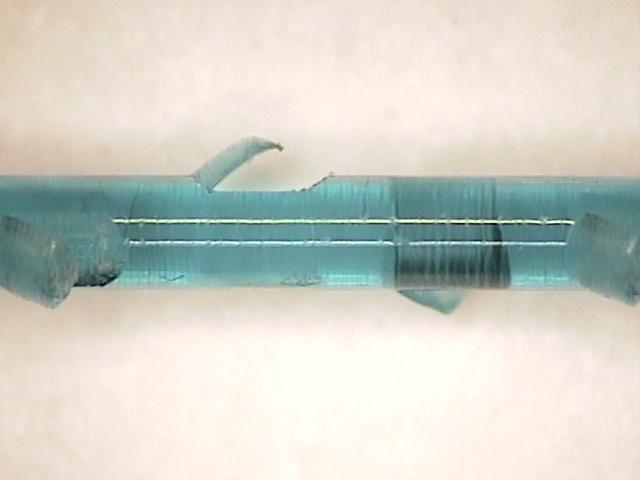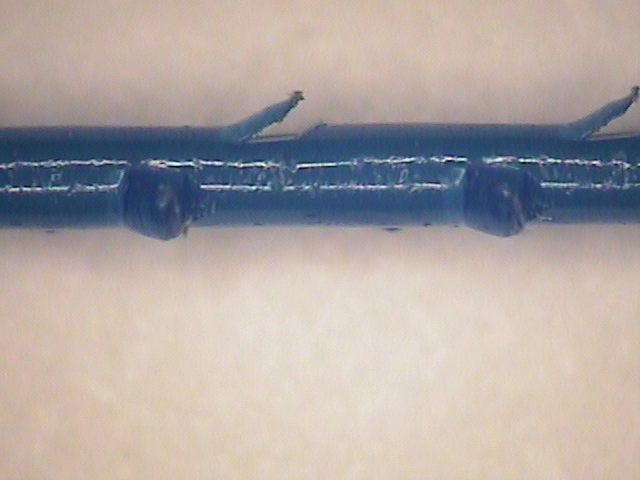Jeffrey Zaruby, DVM DACVS, Kristina Kaminskaya, MS, Jeffrey Miller, MS, Jennifer Lansdowne, DVM MSC DACVS. Covidien, North Haven, CT
Figure 1: A. 3-0 V-Loc™ 180 Device with 17 barbs/cm.
B. 3-0 V-Loc™ PBT Device with 26 barbs/cm.
Objective of Technology:
Tying intracorporeal knots during laparoscopic surgery is one of the more challenging techniques to master, with the integrity of the closure relying on knot security. Advances in suture technology have seen the emergence of barbed suture devices that are self anchoring and obviate the need for knots to secure suture lines. The objective of this study was to compare the relative wound security of single layer enterotomy closures using two barbed suture devices with different barb geometries and spacing.
Description of the Technology & Method of Use:
V-Loc™ 180 Device (Covidien, North Haven, CT) is manufactured from an absorbable polymer a having 17 barbs/cm, whereas V-Loc™ PBT Device (Covidien, North Haven, CT) is manufactured from a non-absorbable polymer b with 26 barbs/cm and shorter barbs (Figure 1). Both devices have unidirectional barbs cut circumferentially around the strand of suture at 120 degree rotations and a loop end effector.
Ten 25 mm enterotomies were created in the stomach (n=2), jejunum (n=4) and colon (n=4) of mature mongrels (N = 13). The enterotomies were closed in a single layer using a simple continuous pattern. The biomechanical wound strength (mmHg of burst strength) of the enterotomies was determined at postoperative day 3, 10, and 21.
Results:
There was insufficient evidence to conclude significant difference in burst strength between the two barbed devices in any tissue at any time point (p<.05). Twenty-two of 26 (85%) enterotomies in the stomach exceeded the upper range of the pressure tranducer (~260 mmHg). At postoperative day 3 one V-Loc™ 180 Device and two V-Loc™ PBT Device stomach enterotomies leaked with mean pressures of 57 and 205 mmHg, respectively. At day 10 one V-Loc™ PBT Device stomach enterotomy burst at 153 mm Hg. For jejunual enterotomies, all the day 10 and 21 enterotomies exceeded the upper limit of the testing apparatus with the exception of one enterotomy for each test article at day 21 (V-Loc™ 180 Device = 232 mmHg and V-Loc™ PBT Device = 127 mmHg). At postoperative day 3 the mean jejunal bursting pressures for samples that did not exceed the limits of the transducer were 88 and 95 mmHg, for V-Loc™ 180 Device (n=9) and V-Loc™ PBT Device (n=10), respectively. In the colon the mean bursting pressures for samples that did not exceed the pressure transducer at postoperative day 3 were 116 (n=7) and 122 mmHg (n=8) for V-Loc™ 180 Device and V-Loc™ PBT Device, respectively. A single V-Loc™ 180 Device colon enterotomy failed at 139 mmHg at postoperative day 10, with all other colon samples exceeding the limits of the pressure transducer.
Conclusions & Future Directions:
In spite of different barb geometries and spacing the biomechanical strength engendered by the two knotless barbed suture devices was not significantly different.
a polyglyconate, a copolymer of glycolic acid + trimethylene carbonate
b polybutester, a copolymer of butylene terephthalate + polytetramethylene ether glycol
Session: Emerging Technology Poster
Program Number: ETP022
View Poster

